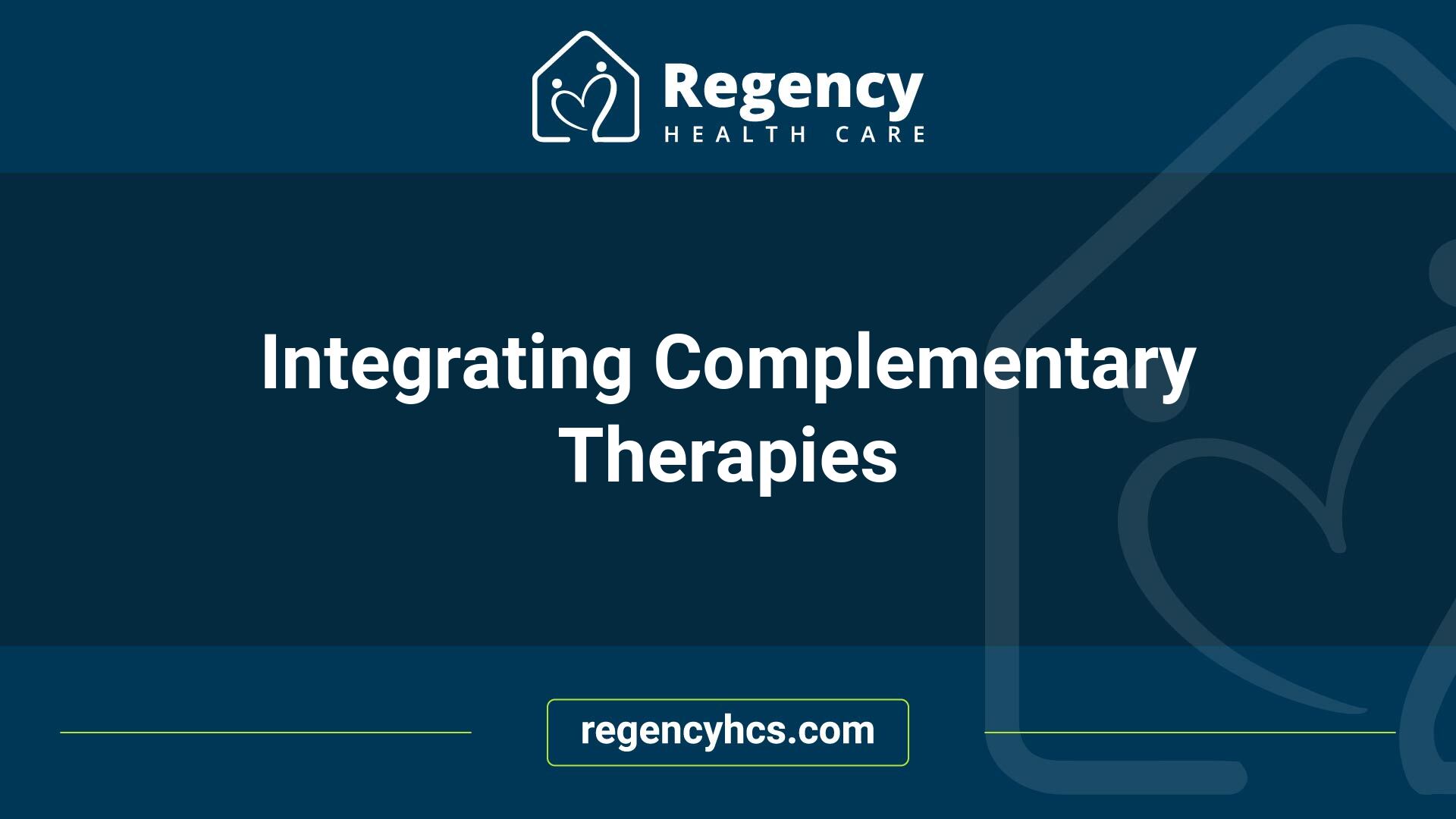Understanding Complementary Therapies
Exploring the realm of integrating complementary therapies, it is essential to grasp the fundamental aspects of these alternative treatments that are utilized alongside conventional medicine. This section will delve deep into the definition of complementary therapies and the diverse types available for consideration.

Definition and Purpose
Complementary therapies, also known as complementary medicine or integrative medicine, encompass a wide range of non-conventional treatment modalities that are utilized in conjunction with traditional Western medicine. These therapies aim to support and enhance the healing process by addressing the physical, emotional, mental, and spiritual well-being of individuals. Emphasizing a holistic approach, complementary therapies focus on treating the individual as a whole rather than just the symptoms or disease.
Types of Complementary Therapies
Complementary therapies span a broad spectrum of practices and treatments, each offering unique benefits and approaches to wellness. Some common examples of complementary therapies include:
- Massage Therapy: Utilizing various techniques to manipulate the body's soft tissues, massage therapy promotes relaxation, reduces muscle tension, and enhances overall well-being.
- Meditation Practices: Engaging in mindfulness and meditation practices aids in reducing stress, improving mental clarity, and fostering a sense of inner peace and balance.
- Dietary Supplements: Incorporating vitamins, minerals, herbs, or other nutritional supplements into one's diet can support overall health and address specific deficiencies or health concerns.
Understanding the diversity and efficacy of these complementary therapies plays a vital role in empowering individuals to make informed decisions about their health and well-being. By embracing a holistic approach that combines conventional medicine with complementary therapies, individuals can optimize their health outcomes and promote overall wellness.
Integration with Conventional Medicine
When it comes to integrating complementary therapies, the TCIM (Traditional, Complementary, and Integrative Medicine) approach stands out as a patient-centric model that combines the best of both conventional medicine and complementary therapies. This approach focuses on treating the whole person, addressing physical, mental, emotional, and spiritual aspects of health [2].
TCIM Approach
Under the TCIM approach, the emphasis is on creating a holistic strategy that considers the individual's unique needs and preferences. By combining the strengths of conventional medicine with complementary therapies, patients benefit from a comprehensive treatment plan that addresses their well-being from multiple angles. This collaborative approach ensures that patients receive the most effective and personalized care tailored to their specific health goals.
Benefits of Integrating Therapies
Integrative medicine, a key component of the TCIM approach, fosters equal partnerships between patients and healthcare providers. This model strives for well-coordinated care among various providers and specialists, integrating conventional healthcare approaches with complementary therapies such as acupuncture and yoga [3].
One of the significant advantages of integrating complementary therapies with conventional medicine is the focus on a patient's holistic well-being. By acknowledging the interconnected nature of physical, mental, emotional, and spiritual needs, integrative medicine offers a more comprehensive approach to healthcare. Individuals, whether healthy or dealing with chronic conditions, can benefit greatly from the relief and support provided by this integrative approach.
Integrative health practices emphasize the importance of multimodal interventions, combining various health approaches to treat the individual as a whole rather than focusing solely on specific organ systems. This approach aims for well-coordinated care among different healthcare providers and institutions, ensuring that patients receive the most effective and personalized treatment plans tailored to their unique needs [4].
By integrating complementary therapies with conventional medicine through the TCIM approach, individuals can experience a more comprehensive and patient-centered healthcare system that addresses their overall well-being, leading to improved health outcomes and quality of life.
Role of Artificial Intelligence
In the realm of healthcare, Artificial Intelligence (AI) is revolutionizing the way traditional, complementary, and integrative medicine intersect. AI plays a pivotal role in enhancing the delivery of care by assisting in early disease detection, devising personalized treatment plans, predicting health trends, and improving patient engagement. Let's delve into how AI is reshaping the landscape of healthcare within the realm of complementary therapies.
AI in Healthcare
AI in healthcare, particularly in the context of Traditional, Complementary, and Integrative Medicine (TCIM), offers a host of benefits. One significant advantage is the ability of AI-powered systems to analyze vast amounts of data quickly and efficiently. This data-driven approach enables healthcare providers to make more informed decisions, leading to better patient outcomes.
By leveraging AI algorithms, healthcare professionals can gain valuable insights into patient health trends, identify potential risks, and tailor treatment plans to meet the individual needs of each patient. Additionally, AI can streamline administrative tasks, optimize workflow efficiencies, and ultimately enhance the quality of care provided to patients.
Integrating AI into TCIM can also introduce virtual health assistants that guide patients through various complementary practices, improve patient engagement, provide relevant health information, address queries, and customize educational materials to align with individual treatment plans and health objectives.
Challenges and Ethical Concerns
Despite the numerous benefits AI brings to healthcare, there are notable challenges and ethical considerations that arise at the intersection of AI and TCIM. These challenges include:
- Data Privacy and Security: The use of AI in healthcare raises concerns about data privacy and security. Safeguarding sensitive patient information and ensuring compliance with regulations are critical considerations that healthcare providers must address.
- Regulatory Complexities: The evolving landscape of AI in healthcare necessitates clear regulations and guidelines to govern its usage. Regulatory complexities can pose barriers to the widespread adoption of AI technologies in TCIM.
- Maintaining the Human Touch: While AI enhances efficiency and accuracy in healthcare delivery, there is a concern about maintaining the human touch in patient-provider relationships. It is essential to strike a balance between technological advancements and compassionate care.
- Bias in AI Algorithms: The integration of AI into TCIM may introduce bias challenges, as AI algorithms can inherit biases present in training data. Addressing bias in AI algorithms is crucial to mitigate disparities in healthcare outcomes and ensure equitable treatment for all patients.
As AI continues to revolutionize the healthcare landscape, it is imperative for healthcare providers and policymakers to navigate these challenges thoughtfully and ethically. By addressing these concerns proactively, the integration of AI into TCIM has the potential to enhance patient care, improve health outcomes, and advance the field of complementary therapies.
Popular Complementary Therapies
Exploring the realm of integrating complementary therapies, it becomes apparent that various methods are gaining popularity among individuals seeking holistic healthcare options. This section will delve into three prevalent complementary therapies: massage therapy, meditation practices, and dietary supplements.
Massage Therapy
Massage therapy is a widely recognized and sought-after complementary therapy that promotes relaxation, relieves muscle tension, and enhances overall well-being. It involves the manipulation of soft tissues using different techniques such as kneading, stroking, and pressure application. Massage therapy is commonly used to alleviate stress, reduce pain, improve circulation, and enhance flexibility.
The therapeutic benefits of massage extend beyond physical relaxation to include mental rejuvenation. Many individuals find massage therapy to be a soothing and rejuvenating experience that helps release stress and tension, promoting a sense of inner calmness. Additionally, massage therapy can aid in the management of various conditions, including chronic pain, anxiety, and even certain musculoskeletal disorders.
To further explore the benefits and considerations of massage therapy, individuals can seek guidance from qualified professionals or healthcare providers. If you are interested in learning more about how massage therapy can complement your healthcare regimen, consider exploring our article on addressing incontinence with dignity.
Meditation Practices
Meditation practices have gained significant traction in recent years as a complementary therapy for promoting mental and emotional well-being. Meditation involves mindfulness and focused attention to achieve a heightened state of awareness and inner peace. Through regular practice, individuals can cultivate mindfulness, reduce stress, improve concentration, and foster emotional resilience.
The popularity of meditation practices stems from their accessibility and versatility, making them suitable for individuals of all ages and backgrounds. Whether practiced individually or in group settings, meditation can be a powerful tool for managing anxiety, enhancing self-awareness, and promoting overall mental clarity.
For those interested in incorporating meditation practices into their daily routine, various resources and guided sessions are available to facilitate the exploration of this transformative practice. To explore additional insights into mindfulness practices at home, visit our article on mindfulness practices at home.
Dietary Supplements
Dietary supplements encompass a wide range of products, including herbs, vitamins, minerals, and probiotics, that are used to supplement the diet and support overall health. These supplements are widely available and marketed for various health purposes, such as boosting immunity, improving cognitive function, or enhancing physical performance.
According to the 2012 National Health Interview Survey (NHIS), 17.7% of American adults had used a dietary supplement other than vitamins and minerals in the past year. Fish oil emerged as one of the most commonly used nonvitamin, nonmineral dietary supplements, reflecting the growing interest in incorporating nutritional supplements into daily wellness routines.
While dietary supplements can offer benefits when used appropriately, it is essential to consult healthcare providers to ensure their safety and efficacy, especially when considering potential interactions with medications. Further research is warranted to fully understand the impacts and interactions of dietary supplements on individual health profiles.
Embracing the diversity of popular complementary therapies such as massage therapy, meditation practices, and dietary supplements allows individuals to explore holistic approaches to health and well-being. By incorporating these therapies mindfully and under professional guidance, individuals can optimize their overall wellness journey and discover the synergy between conventional healthcare practices and complementary therapies.
Differences in Therapies
When exploring the realm of integrating complementary therapies, it is essential to understand the distinctions between complementary and alternative approaches, as well as the concept of integrative medicine.
Complementary vs. Alternative
In the evolution of healthcare practices, the terminology around complementary and alternative medicine (CAM) has transitioned to embrace a more inclusive and collaborative approach. These practices are now commonly referred to as complementary and integrative medicine, integrative medicine and health, or simply integrative medicine.
Complementary therapies are used alongside conventional medical treatments to enhance well-being and symptom management. They are not intended to replace standard medical care but rather to complement and support it. For instance, a cancer patient undergoing chemotherapy may engage in meditation practices to alleviate stress and promote relaxation.
On the other hand, alternative therapies are pursued in place of traditional medical treatments. While some individuals may opt for alternative therapies due to personal beliefs or preferences, it is important to exercise caution, as certain alternative practices may lack scientific validation or could potentially interact negatively with prescribed medications.
Integrative Approaches
In the landscape of modern healthcare, the concept of integrative medicine has gained momentum. Integrative medicine combines the most well-researched conventional medical practices with evidence-based complementary therapies to deliver comprehensive and individualized care. Unlike alternative medicine, which may involve solely non-conventional treatments, integrative medicine integrates the best of multiple healthcare modalities to optimize patient health outcomes.
By blending the strengths of conventional medicine with complementary approaches such as massage therapy, meditation practices, and dietary supplements, integrative medicine offers a holistic and patient-centered approach to healing. This collaborative model emphasizes the importance of treating the whole person, considering physical, emotional, mental, and even spiritual aspects to promote overall well-being.
For individuals seeking a balanced and comprehensive approach to healthcare, integrative medicine provides a framework for incorporating complementary therapies in a safe and effective manner. Consultation with healthcare providers who specialize in integrative medicine can help individuals navigate the complexities of treatment options and make informed decisions regarding their health and wellness journey.
Safety and Efficacy Considerations
Ensuring the safety and effectiveness of integrating complementary therapies is paramount for individuals seeking holistic approaches to healthcare. Two critical aspects to consider when exploring complementary therapies are consulting healthcare providers and assessing the scientific validity of these therapies.
Consulting Healthcare Providers
Before embarking on any complementary therapy journey, it is advisable to consult with a traditional healthcare provider. It is essential to keep all healthcare practitioners informed about the therapies being considered and used. By maintaining open communication with healthcare providers, individuals can receive comprehensive care that takes into account both conventional medical treatments and complementary therapies.
Consulting with healthcare professionals allows individuals to receive personalized guidance on the potential benefits and risks associated with specific complementary therapies. During these consultations, it is recommended to inquire about the qualifications and training of complementary therapy practitioners to ensure safe and effective care. Individuals should be cautious of practitioners who advise abandoning conventional medical treatments without sound reasoning.
Scientific Validity of Therapies
To determine the scientific validity and efficacy of complementary therapies, individuals are encouraged to conduct thorough research and rely on credible sources of information. Resources such as the National Center for Complementary and Integrative Health website provide evidence-based insights and information on various complementary health approaches.
Among the popular complementary approaches, dietary supplements play a significant role in healthcare practices. According to the 2012 National Health Interview Survey, dietary supplements, including herbs, vitamins, minerals, and probiotics, are widely used in the United States. It is important to note that 17.7% of American adults used dietary supplements other than vitamins and minerals in the past year. However, consulting a healthcare professional before incorporating dietary supplements into one's regimen is advised to ensure proper understanding of their effects, safety, and potential interactions with medications [4].
By engaging healthcare providers and assessing the scientific validity of complementary therapies, individuals can make informed decisions about incorporating these practices into their healthcare routines. Collaboration between conventional healthcare professionals and complementary therapy practitioners can help maximize the benefits of both approaches and enhance holistic wellness.
Usage Trends and Popularity
When it comes to integrating complementary therapies, understanding the global utilization patterns and regional variances in the use of these therapies is essential. Different countries and cultures have distinct preferences when it comes to incorporating complementary therapies into their healthcare practices.
Global Utilization Patterns
- Australia: Two-thirds of people in Australia are estimated to use complementary and alternative therapies. This widespread usage signifies the growing acceptance and interest in complementary therapies among Australians. It's important to note that while these therapies can offer benefits, some complementary medicines may contain active ingredients that can cause adverse effects, emphasizing the need for caution and informed decision-making.
- United Kingdom: According to a British telephone survey conducted by the BBC in 1998, around 20% of adults in the United Kingdom had used alternative medicine in the past 12 months [7]. This indicates a significant portion of the population turning to alternative approaches for healthcare needs. The popularity of alternative medicine reflects a shift towards a more holistic and diverse healthcare landscape in the UK.
- India: In India, traditional medicine systems like Ayurveda, Siddha, Unani, and Homeopathy are licensed by the government, despite the lack of strong scientific evidence. With approximately half of the general population in developed countries utilizing complementary and alternative medicines, the integration of these practices into mainstream healthcare is becoming increasingly prominent.
Regional Variances in Use
- Australia: In Australia, women and well-educated individuals are among the most frequent users of complementary therapies [5]. Factors influencing the use of complementary therapies include cultural traditions, personal beliefs, and individual preferences. Understanding these variances can help tailor healthcare interventions to cater to diverse patient needs and preferences.
- India: While traditional Indian medicine systems hold a significant place in the healthcare landscape, activities like Panchakarma and massage therapy related to Ayurveda are also under government licensing. The licensing of these practices highlights the cultural significance and acceptance of traditional therapies in India. As naturopathy is set to be licensed soon, the integration of these therapies with conventional medicine is expected to accelerate.
By examining the global trends and regional disparities in the utilization of complementary therapies, healthcare providers and policymakers can better understand the diverse needs and preferences of populations worldwide. Incorporating insights from these patterns can help foster a more inclusive and comprehensive approach to healthcare delivery, embracing the principles of integrative health for holistic well-being.
Future Trends and Research
As the healthcare landscape continues to evolve, the growth of integrative health practices and ongoing research in complementary medicine play a significant role in shaping the future of healthcare.
Growth of Integrative Health Practices
Integrative health practices, which combine conventional medicine with complementary therapies, are steadily gaining traction in the healthcare field. Institutions like the Mayo Clinic and the Cleveland Clinic are incorporating integrative approaches to provide patients with a comprehensive and holistic approach to healthcare.
The integration of complementary therapies with conventional medical treatments offers patients a more personalized and patient-centered approach to healing. By considering the whole person—mind, body, and spirit—integrative health practices aim to optimize health and well-being while addressing underlying causes of illness. This shift towards a more integrative model of care signifies a growing recognition of the value of complementary therapies in enhancing overall health outcomes.
Research Areas in Complementary Medicine
Research in complementary medicine, conducted by organizations like the National Center for Complementary and Integrative Health (NCCIH) and the National Center for Biotechnology Information (NCBI), is at the forefront of exploring the safety, efficacy, and potential benefits of various complementary therapies.
Studies conducted by the (NCBI) have focused on evaluating the effectiveness of complementary therapies in managing chronic conditions, improving quality of life, and reducing symptoms. Research initiatives encompass a wide range of therapies, including acupuncture, herbal remedies, and mind-body practices, shedding light on their mechanisms of action and therapeutic potential.
By fostering collaboration between researchers, healthcare providers, and complementary therapy practitioners, ongoing research endeavors aim to expand our understanding of how these therapies can be integrated into mainstream healthcare practices. Through rigorous scientific inquiry and evidence-based approaches, the field of complementary medicine continues to advance, paving the way for innovative treatment strategies and improved patient outcomes.
References
[1]: https://my.clevelandclinic.org/health/articles/complementary-therapy
[2]: https://pmc.ncbi.nlm.nih.gov/articles/PMC10879672/
[3]: https://my.clevelandclinic.org/health/treatments/integrative-medicine
[5]: https://www.betterhealth.vic.gov.au/health/conditionsandtreatments/complementary-therapies
[6]: https://www.mayoclinic.org/tests-procedures/complementary-alternative-medicine/about/pac

How to Manage HHA Schedules for Consistent Care
April 11, 2025
Ensuring Consistent Home Health Care: Mastering HHA Scheduling

The Benefits of In-Home Physical Therapy
April 11, 2025
Exploring the Convenience and Effectiveness of Home-Based Physical Therapy

How Home Care Promotes Mental Health for Seniors
April 11, 2025
Enhancing Well-being: The Role of Home Care in Supporting Senior Mental Health

How Family Caregivers Can Support a Loved One with TBI
April 10, 2025
Empowering Caregivers: Navigating the Journey of Supporting TBI Recovery

How Home Health Aides Support Individuals with TBI in Daily Living
April 10, 2025
Unveiling the Vital Role of Home Health Aides in TBI Care

How CDPAP Supports Individuals with Learning Disabilities
April 10, 2025
Empowering Choice and Independence: The Impact of CDPAP on Learning Disabilities



